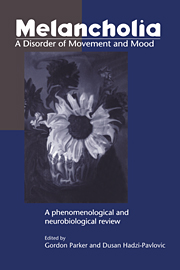Book contents
- Frontmatter
- Contents
- List of contributors
- Acknowledgments
- Introduction
- Part One Classification and Research: Historical and Theoretical Aspects
- 1 Issues in Classification: I. Some Historical Aspects
- 2 Issues in Classification: II. Classifying Melancholia
- 3 Issues in Classification: III. Utilising Behavioural Constructs in Melancholia Research
- 4 Issues in Classification: IV. Some Statistical Aspects
- Part Two Development and Validation of a Measure of Psychomotor Retardation as a Marker of Melancholia
- Part Three The Neurobiology of Melancholia
- The CORE Measure: Procedural Recommendations and Rating Guidelines
- References
- Author Index
- Subject Index
2 - Issues in Classification: II. Classifying Melancholia
from Part One - Classification and Research: Historical and Theoretical Aspects
Published online by Cambridge University Press: 04 August 2010
- Frontmatter
- Contents
- List of contributors
- Acknowledgments
- Introduction
- Part One Classification and Research: Historical and Theoretical Aspects
- 1 Issues in Classification: I. Some Historical Aspects
- 2 Issues in Classification: II. Classifying Melancholia
- 3 Issues in Classification: III. Utilising Behavioural Constructs in Melancholia Research
- 4 Issues in Classification: IV. Some Statistical Aspects
- Part Two Development and Validation of a Measure of Psychomotor Retardation as a Marker of Melancholia
- Part Three The Neurobiology of Melancholia
- The CORE Measure: Procedural Recommendations and Rating Guidelines
- References
- Author Index
- Subject Index
Summary
Introduction
In the previous chapter, an overview was provided on the Unitarian versus binarian debate. Two issues briefly noted there will be considered in greater depth in this chapter: firstly, the extent to which certain clinical features have been demonstrated as either specific to or over-represented in the melancholic type of depression; secondly, the extent to which the debate has been assisted by statistical analyses. Both issues converge in our progressive attempt to define melancholia, and in considering its status – as either a discrete categorical entity with specific clinical features or a dimensionally severe expression of depression.
Clinical Features of Melancholia
While there has clearly been an extended controversy about the status and classification of melancholia (synonyms include “endogenous,” “endogenomorphic” and “autonomous” depression), suggested defining characteristics (e.g., Kendell 1968; Klerman 1971; Young et al. 1986) have included:
(i) a distinctive pattern of symptoms and signs;
(ii) the greater relevance of genetic and other biological (as opposed to psychosocial) determinants;
(iii) concomitant evidence of disturbed biological functioning, especially of the hypothalamic-pituitary-adrenal axis; and
(iv) selective response to physical treatments (i.e., antidepressant medication and electroconvulsive therapy).
Our focus, both in this section and in this book, is on the clinical definition of melancholia and the extent to which symptoms and signs either have specificity to or are over-represented in melancholia. In essence, we respect the view of Ní Brolcháin that classification should be restricted “in the first instance, to mental state items.
- Type
- Chapter
- Information
- Melancholia: A Disorder of Movement and MoodA Phenomenological and Neurobiological Review, pp. 20 - 37Publisher: Cambridge University PressPrint publication year: 1996
- 10
- Cited by

